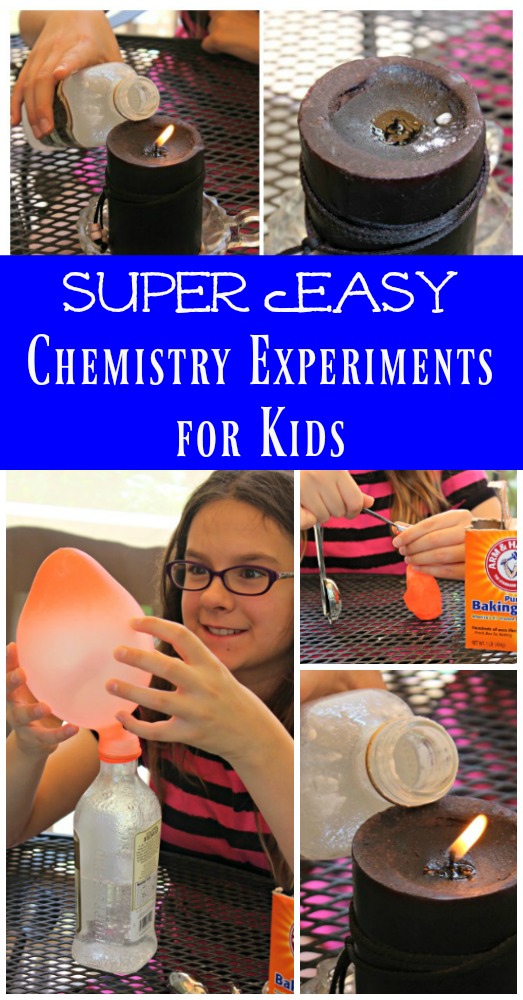Try these cool chemistry experiements for kids using carbon dioxide & see the invisible!
Summer Science is back and we are exploring chemistry this week!
We’ve worked our way through geology, biology, astronomy and physics. If you’ve missed any of the science activiites we are sharing along with those from our super cool collaborator Inspiration Laboratories, you can find them all linked below for each of the science areas.
Chemistry is the area of science that focuses on investigating what makes up matter and how these properties change, combine and interact with one another.
One of the most frequent thoughts when you mention ‘chemistry’ is some type of bubbling liquid or an explosion in a lab (ahh, the days of high school science class 🙂
But in today’s activity, we are actually going to focus on one of the ‘invisible’ areas of chemistry!
Chemistry Experiments for Kids
Sometimes when you mix the right items together, you can produce something really cool!
And in this experiment, we are going to mix two very common household items to create a gas — CO2 which is carbon dioxide.
A few things to tell kids about carbon dioxide:
- It’s an invisible gas or vapor
- It doesn’t contain any odor
- When we breathe, we exhale carbon dioxide
Blowing Up a Balloon with CO2

Believe it or not, you can create carbon dioxide using items from around the house — it’s just a mixture of vinegar and baking soda!
For our balloon experiment, we used 1.5 cups of vinegar and 1 teas. of baking soda.
Step 1: Pour the vinegar into a bottle with a small neck.

Step 2: Measure out 1 teas. of baking soda and drop it into a balloon.
Be sure that the baking soda drops into the large area of the balloon as much as possible.

Step 3: Stretch the balloon around the neck of the bottle (already filled with vinegar) BUT BE SURE to hold the top of the balloon over the side of the bottle so the baking soda remains in the balloon.

Step 4: Stand the balloon upright being sure to hold it around the neck of the bottom and allow the baking soda to drop into the bottle — the reaction will take place quickly and the balloon will begin to inflate.
You can see the mixture will bubble as it creates the gas.

The balloon will inflate and then as the gas subsides, it will get smaller — if the kids want to take the balloon off and tie it, I would suggest watching closely so you can catch it on its larger size.
Kids really do love this experiment — it’s so hands-on and a great way to ‘see’ and invisible gas being produced.
The Candle Trick
Using the same bottle of vinegar, we are going to create more carbon dioxide and blow out a candle. Remind your kids that they blow out a candle when they exhale — again, producing carbon dioxide — so this is the same idea.
For this experiment, the same ingredients and measurements will be used (1.5 cups of vinegar and 1 teas. of baking soda).

Step 1: Light a candle (using all the ‘fun police’ rules and precautions with kids — be careful of the flame, keep it away from younger kids who might lean over it, don’t leave it unattended — you know the drill!)

Step 2: Pour 1 teas. of baking soda into the bottle of vinegar — you can use the same vinegar/bottle from the previous experiment as long as you use it within a few minutes.
If you do the experiments on different days, you’ll need fresh vinegar.

Step 3: While the mixture is bubbling, slowly & carefully tip the bottle over the flame as if you were going to pour the liquid on the candle — it only takes a small tip as carbon dioxide is heavier than air.
You’ll see the flame flicker and then POOF!, it will be gone!
More Chemistry for Kids
Another great activity that explores chemistry is baking — head over to visit Inspiration Laboratories and see how you can make cup-cakes while you learn about science!
And if you’d like to learn a little more, try one of these fun science books that explore chemistry. We’ve included affiliate links for additional information on each of them.
What Is the World Made Of? All About Solids, Liquids, and Gases – this is one of our favorite science book series for younger kids (ages 3 – 8 years) because the books do a wonderful job of explaining science in a way kids can really understand. This installment helps kids learn about the three types of matter.
For older kids, try Why Is Milk White?: & 200 Other Curious Chemistry Questions which shares some really interesting facts and questions that focus on chemistry concepts. You’ll find easy-to-understand explanations along with some fun experiments the kids will enjoy.
Be sure to visit all of the awesome book lists & activities for all the science topics!

June 25th — {Biology}
Books & Websites that explore Plants, Animals & the Human Body
Backyard Earthworm Experiments
July 2nd — {Geology}
The Science of Rocks, Fossils and Volcanoes
Digging for Dinosaurs — Learn to be a Paleontologist
July 9th — {Astronomy}
Explore the Night Sky – Marshmallow Constellations
Solar System Activities for Kids
July 16th — {Physics}
Fantastic Forces & Water Rockets
Exploring Color and Temperature
July 23rd — {Chemistry}
Make a Cup Cake (Chemistry of Baking)
Blowing Up Balloons/Blowing Out Candles
July 30th — {Ecology}
Kids Activities that Explore Ecology
Create an Under the Sea World: Exploring Ocean Zones



